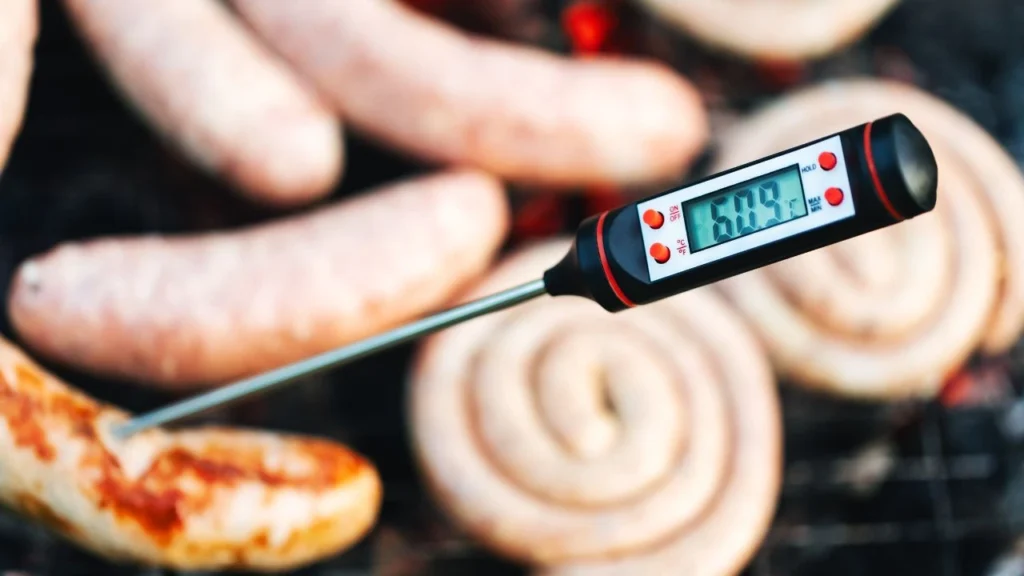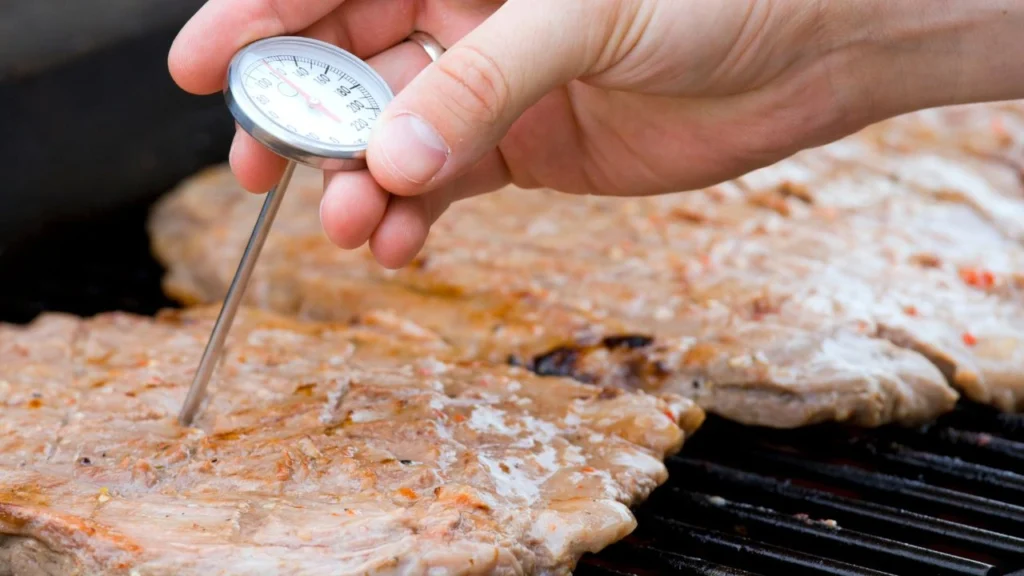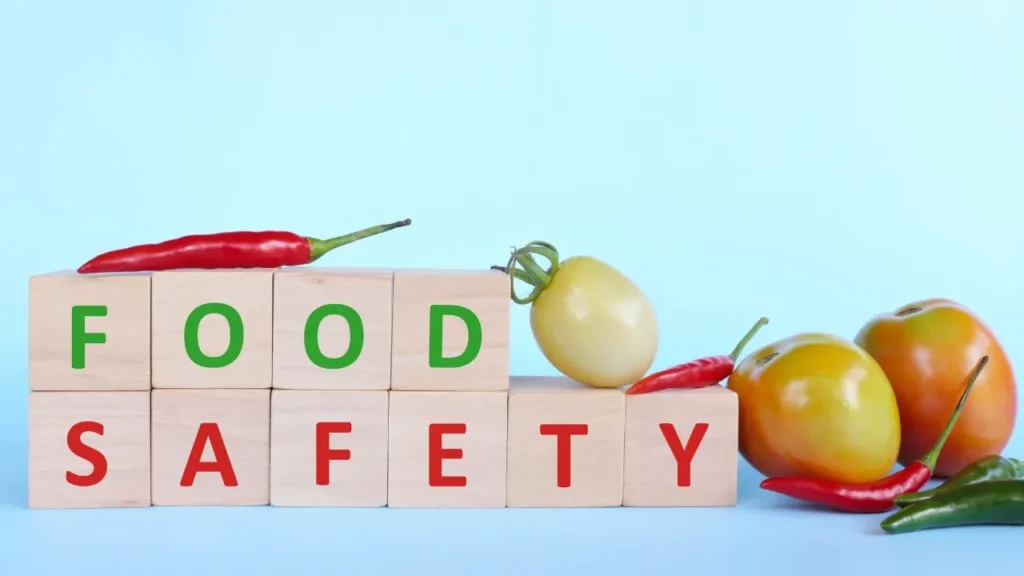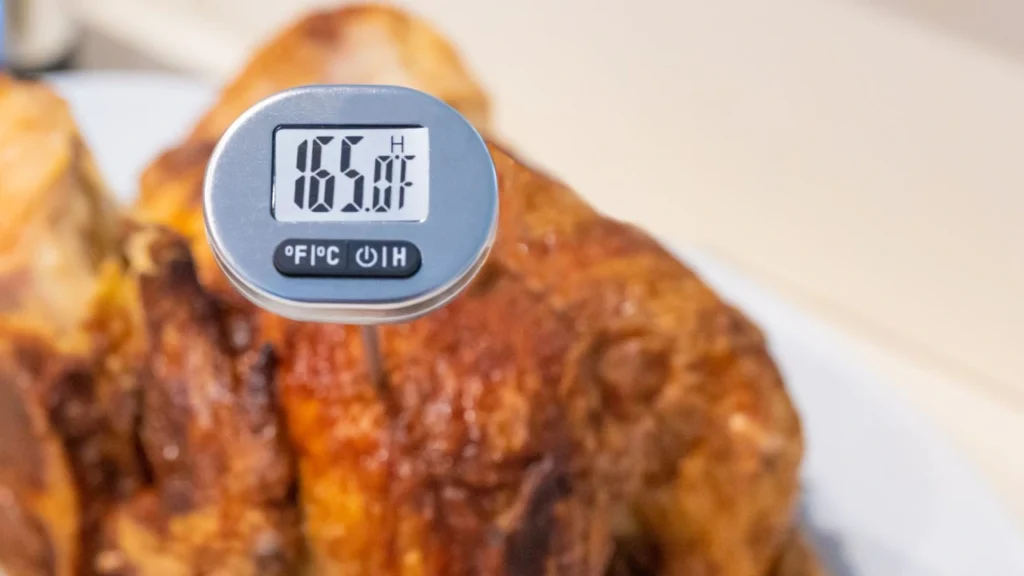In a busy commercial kitchen, food safety and precision are top priorities, and one tool stands out in achieving both: the probe thermometer. But what is a probe thermometer? It’s a device used to measure the internal temperature of food, ensuring every dish is cooked safely and to perfection. While home cooks often rely on guesswork, professional chefs depend on accurate readings to prevent foodborne illnesses and reduce waste. From monitoring a roast’s core temperature to checking freezer conditions, a probe thermometer is essential for consistency and quality. Let’s explore how this tool can elevate your kitchen’s performance.
Understanding Probe Thermometers: Definition and Components
A probe thermometer is an essential tool in any commercial kitchen, ensuring food is cooked and stored safely with precision. Different types of probe thermometers are designed for specific tasks, each offering unique benefits:
- BBQ Smoking Probes: Measure ambient grill temperatures and internal meat temps for perfect smoking.
- Food Probes: Prevent undercooking or overcooking, ensuring diner safety and satisfaction.
- Resistance Temperature Detectors (RTDs): Highly accurate but more expensive, ideal for precision cooking.
- Thermocouple Probes: Deliver fast readings in 2–5 seconds, perfect for busy kitchens.
- Semiconductor Sensors: Take up to 20 seconds for readings, suitable for large food batches.
- NTC Thermistors: Reliable, fast, and accurate across a wide temperature range, great for BBQ cooking.
Top models like the Thermapen 3 offer a wide temperature range, while the ThermaLite 1 ensures long-lasting accuracy. The Waterproof Food Probe Thermometer adds durability and max/min recording features, ideal for diverse kitchen conditions.
Each type of thermometer serves a specific purpose, from grilling meats to baking casseroles. Choosing the right probe thermometer improves accuracy, consistency, and safety—ensuring every dish meets the highest culinary standards.
How Does a Probe Thermometer Work?

If you’re a chef or run a restaurant, knowing how a probe thermometer works is key. It helps keep your food safe and top-quality. When choosing between a digital probe thermometer vs instant-read thermometer, understanding this tool can guide you.
Temperature Sensing at the Tip of the Probe
Measuring temperature starts when the probe tip touches the food. It responds to the food’s heat. A special material at the tip changes in response to heat. This change gives us a reading.
Conversion of Temperature to Electrical Signal
The tip sends the temperature to the thermometer’s digital part. Inside the probe, elements like thermistors or thermocouples sense the heat. They turn the heat into an electrical signal. This travels to the thermometer’s brain.
Processing and Display of Temperature Reading
The thermometer’s microprocessor gets this signal. It uses stored data to ensure the reading is right. Then, the temperature shows on the screen. Chefs can see the exact temperature right away. This is vital for managing a kitchen well.
Thermistors: Temperature Range -40°C to 125°C (can go up to 325°C)
Thermistors in digital thermometers can sense a wide range of temperatures. They’re great for many kitchen tasks. So, knowing how a probe thermometer works is crucial. This helps make sure food is cooked safely.
A probe thermometer’s job is important for cooking right. It helps with timing, temperature, and texture in the kitchen. When choosing, think about speed, accuracy, and the temperature range you need. This will help your kitchen run smoothly.
When to Use a Probe Thermometer in Commercial Kitchens
A probe thermometer is essential for food safety and quality in commercial kitchens. It ensures meals are cooked, stored, and reheated at the right temperatures. Here’s when to use one:
- Checking Cooked Meats: Ensure poultry, beef, and pork reach safe internal temperatures.
- Monitoring Storage Temperatures: Regularly check both cold storage and hot holding to prevent spoilage.
- During Cooking: Verify temperatures, especially when combining ingredients later.
- Reheating Foods: Ensure previously cooked foods reach safe temperatures, especially in buffets.
Choosing the right thermometer is crucial. Brands like Manitowoc and Vulcan offer reliable, quick-read options for accurate results. Proper use of a probe thermometer not only meets health standards but also ensures every dish is safe, delicious, and consistent.
How to Properly Use a Probe Thermometer

Knowing how to use a probe thermometer right is key in any busy kitchen. It makes sure every meal is perfect and safe. Here are tips to get the most out of this important tool:
- Insertion Technique: Place the probe in the meat’s thickest part, away from bone or dense tissues. This helps avoid wrong temperature readings.
- Waiting Period: Give the thermometer a few seconds to settle after insertion. This ensures the temperature shown is correct, preventing any health risks.
- Multi-Point Checking: Always check the temperature in several spots, especially for big or oddly shaped foods. This confirms the entire item is evenly cooked.
- Consistency with Calibration: Regularly calibrating your thermometer is important. This keeps it accurate. Use the cold calibration method, which is safe and effective.
- Cooking to Exact Specifications: Know the right temperatures for different foods. For example, poultry needs to reach 165°F, and steak’s temperature varies by preference.
- Hygiene and Maintenance: Clean and sanitize your thermometer well to avoid contaminating your food. This is crucial for health and safety.
By following these proper probe thermometer usage tips, you’ll serve great meals safely. Plus, you’ll boost your kitchen’s reputation for quality and safety.
Food Safety

Knowing the temperature danger zone is crucial for food safety in kitchens. This zone, 41-135°F, is where bacteria grow fast. Keeping food out of this zone is vital to stop foodborne illnesses and keep diners safe. Using a probe thermometer helps achieve this goal and offers many benefits of using a probe thermometer in the kitchen.
Temperature Danger Zone: 41-135°F (5-57°C)
The temperature danger zone is where food can become unsafe. A probe thermometer quickly checks temperatures. This keeps food safe from bacteria and prevents health issues.
Bacteria Proliferation Peak: 70-125°F
In the danger zone, the worst range for bacteria is 70-125°F. Here, bacteria multiply quickly. Probe thermometers are crucial for keeping food temperatures in check.
Maximum Safe Duration in Danger Zone: 4 hours
Food shouldn’t stay in the danger zone for over four hours. The longer it stays, the higher the bacteria risk. A probe thermometer makes it easy to keep track of food temperatures.
Using a probe thermometer regularly is more than just following rules. It’s a key step to better food safety. By knowing and managing the temperature danger zone with the right tools, you keep your customers safe and raise your kitchen’s quality.
Types of Probe Thermometers for Commercial Kitchens
In commercial kitchens, the right tools are key for cooking with precision. Knowing about different probe thermometers can boost your efficiency and improve food safety. Let’s explore the various thermometers you can use and how they fit into different cooking tasks.
Digital Instant-Read Thermometers
These thermometers are essential in today’s kitchens. The comparison between digital probe and instant-read thermometers shows that instant-reads provide fast results. They are ideal for quick checks and come with a digital display. This feature makes it easier to read temperatures without guessing.
Thermocouple Thermometers
Thermocouple thermometers are known for their quickness. They can read temperatures from the outer surface to the middle of food in 2 to 5 seconds. Able to handle temperatures up to 2,500 degrees Fahrenheit, they’re perfect for high-heat uses like making sugar syrups or frying.
Thermistor Thermometers
Thermistor thermometers offer good accuracy without being too expensive. They give fast temperature readings and work well with any food thickness. But, they have some limitations with recalibration, which is something to remember.
Infrared Thermometers with Probe Attachments
New technology introduced infrared thermometers that come with probe attachments. These tools measure surface temperatures without touching the food. This feature helps keep things clean and sanitary. They’re great for checking temperatures in fridges or at the receiving dock.
Each type of probe thermometer has its own benefits for commercial kitchens. Choosing the right one helps chefs and managers closely monitor temperatures. This is important for creating perfect dishes and keeping food safe.
Maintenance and Care of Probe Thermometers

Keeping your probe thermometers in good shape is vital. It ensures they work right and last longer. These tools are a big deal in making sure food is safe in eateries. For those running a restaurant, taking care of these thermometers helps follow health laws. Plus, it keeps your food safe for customers. Here’s a detailed plan for taking care of your thermometers:
Regular Cleaning and Sanitizing Procedures
- Wash the probe with soapy water before and after you use it. This stops germs from spreading.
- Clean the probe with special wipes after you check different foods. This keeps it clean.
- Disinfect the probe with alcohol. Then, rinse it in warm water to remove any left-over germs.
- Let the thermometer dry on its own in a spotless area. This is key to avoid germs growing on it.
Proper Storage to Prevent Damage
- Keep the thermometer in a dry and cool area away from the sun and extreme heat or cold. It’s best to store them at 40 to 149 degrees Fahrenheit (4 to 65 degrees Celsius).
- Have a specific place for storing them. Use covers or sheaths to keep them clean after you wash them.
- Make sure not to use the probe to stir or open things. It can get damaged that way.
Battery Replacement (for Digital Models)
Change the batteries in your digital thermometers from time to time. If batteries get weak, the thermometer might not give the right temperature. This could lead to serving undercooked food, a real health risk. It’s wise to have extra batteries ready and to check their power often.
Periodic Calibration Checks
It’s important to regularly check if your thermometer is giving accurate readings. Here’s how to do it:
- Test the thermometer with the ice water method. Dip its probe into ice and water. It should show 32 degrees Fahrenheit (0 degrees Celsius).
- If the reading is wrong, follow the maker’s guide to adjust it. Or you might need help from a professional.
- Remember to check the calibration every six months. Also, do it if the thermometer was dropped or exposed to too hot or cold temperatures.
Following this full guide helps keep your thermometers working well. It builds trust in your team and your customers. They’ll know they’re eating food that’s both tasty and safe.
Ensuring Food Safety and Quality with Probe Thermometers
Probe thermometers are essential for keeping food safe and delicious in commercial kitchens. They ensure food meets safety laws, requiring accuracy within ±1°C. A good thermometer must be precise, usually within ±0.5°C to ±1°C. Experts recommend placing the probe in the thickest part of the food without touching the container’s sides or bottom. These thermometers are also useful in a list of food truck equipment, helping ensure that food safety standards are consistently met on the go.
Brands like Lavatools Javelin PRO Duo and Weber iGrill 2 offer fast, accurate readings, helping kitchens maintain safety and serve perfect meals every time.
FAQ
What are the latest statistics on foodborne illnesses in commercial kitchens?
According to recent data, foodborne illnesses affect approximately 1 in 6 people annually in the United States, with commercial kitchens being a significant source of outbreaks. Common pathogens include Salmonella, E. coli, and Listeria, often linked to improper food handling and temperature control.
What are the key components of a probe thermometer and their functions?
A probe thermometer typically consists of a metal probe, a temperature sensor, a digital or analog display, and a power source. The probe detects food temperature, while the display provides accurate readings to ensure safe cooking and storage conditions.
How do thermocouple and thermistor technologies differ in probe thermometers?
Thermocouple thermometers offer a wider temperature range and faster response time, making them suitable for high-heat applications. Thermistor thermometers, on the other hand, are more precise within a narrower temperature range, ideal for monitoring delicate food items.
What are the critical temperature danger zones for food safety in commercial kitchens?
The temperature danger zone for food safety is typically between 40°F (4°C) and 140°F (60°C). Within this range, bacteria can multiply rapidly, increasing the risk of foodborne illness if food is not stored or cooked properly.
What are the best practices for calibrating a probe thermometer?
Calibrate probe thermometers regularly using the ice water method (32°F or 0°C) or boiling water method (212°F or 100°C). Ensure adjustments are made according to the thermometer’s manual to maintain accuracy in temperature readings.
Resources
https://www.anfponline.org/docs/default-source/legacy-docs/docs/ce-articles/fpc092024.pdf
https://www.morsafesupplies.com/2023/03/12/what-is-a-probe-thermometer-used-for








